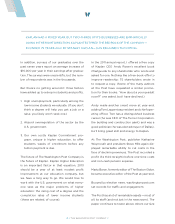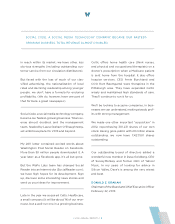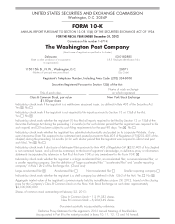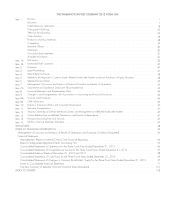Washington Post 2012 Annual Report Download - page 16
Download and view the complete annual report
Please find page 16 of the 2012 Washington Post annual report below. You can navigate through the pages in the report by either clicking on the pages listed below, or by using the keyword search tool below to find specific information within the annual report.The enactment in August 2008 of the U.S. Federal Higher Education Opportunity Act (HEOA), which reauthorized the
Higher Education Act, changed the methodology that will be used to calculate cohort default rates. Under the revised
law, the period of time for which student defaults are tracked and included in the cohort default rate calculation is
extended by one year, which is expected to increase the cohort default rates for most institutions. The change to the
calculation period became effective with the calculation of institutions’ official three-year cohort default rates for the U.S.
Federal fiscal year ending September 30, 2009; those rates were issued by the DOE in 2012. The DOE will not impose
sanctions based on rates calculated under this new methodology until rates for three consecutive years have been
calculated, which is expected to occur in 2014. Until that time, the DOE will continue to calculate rates under the old
method and impose sanctions based on those rates. The revised law also increases the threshold for ending an
institution’s participation in certain Title IV programs from 25% to 30% for three consecutive years, effective for three-year
cohort default rates issued beginning in fiscal year 2012. The revised law changes the threshold for placement on
provisional certification to 30% for two of the three most recent fiscal years for which the DOE has published official three-
year cohort default rates. For the Federal fiscal year ending September 30, 2009, five KHE Campuses OPEIDs,
representing 2.6% of KHE’s 2012 revenue, had three-year rates over 30%, and no KHE OPEID had a three-year rate
over 40%.
The two-year cohort default rates for Kaplan University for the U.S. Federal fiscal year periods 2010 and 2009 were
16.8% and 17.3%, respectively. The two-year cohort default rates for the remaining KHE reporting units for those U.S.
Federal fiscal year periods ranged from 7.5% to 25.3% for 2010 and 9.8% to 23.9% for 2009. One campus
(Pittsburgh) has a two-year rate of 25.3% for 2010. This is the first year that a campus has exceeded the 25% threshold,
and we have not received any communication to date that would suggest that the DOE will take any action with respect
to the Pittsburgh campus based on its default rate. For 2010, the combined default rate for all KHE reporting units as a
whole was 16.5%
Kaplan believes that student loan default rates tend to correlate directly to a student’s family income level, such that lower
income students will have higher default rates. KHE’s student population generally tends to come from lower income
groups than those of other providers of higher education, including other for-profit providers. In addition, because KHE
receives a significantly lower level of U.S. taxpayer-funded grants and subsidies than community colleges, state schools
and not-for-profit schools, KHE’s schools are more dependent on tuition, and its students are more dependent on loans.
Kaplan has dedicated resources to help students who are at risk of default. Kaplan personnel contact students and
provide assistance, which includes providing students with specific loan repayment information, lender contact information
and debt counseling. Kaplan has also implemented a financial literacy and counseling program for current students, and
provides career counseling services. However, no assurances can be given that these resources will enable Kaplan’s
schools to maintain cohort default rates below the thresholds for sanctions.
In the fourth quarter of 2010, most programs at Kaplan University and KHE Campuses implemented the Kaplan
Commitment. Under this program, students may enroll in classes for several weeks and assess whether their educational
experience meets their needs and expectations before incurring any significant financial obligation. Kaplan also conducts
assessments to help determine whether students are likely to be successful in their chosen course of study. Students who
choose to withdraw from the program during this time frame (risk-free period) and students who do not pass the
assessment do not have to pay for the coursework. Kaplan believes that the Kaplan Commitment will help ensure that its
student body is more committed, better academically prepared and more likely to complete their programs. In Kaplan’s
experience, students who withdraw prior to program completion demonstrate a higher loan default rate than those who
continue through to graduation. Kaplan is hopeful that the Kaplan Commitment will also improve cohort default rates as
students who might have withdrawn previously with debt will now leave a program under the Kaplan Commitment.
Although Kaplan has taken the above steps and dedicated resources to mitigate the increased risk of student loan defaults
by its students, there is no guarantee that such efforts will be successful in reducing cohort default rates. Kaplan believes
that the Kaplan Commitment program is unique and reflects Kaplan’s commitment to student success.
4THE WASHINGTON POST COMPANY
























